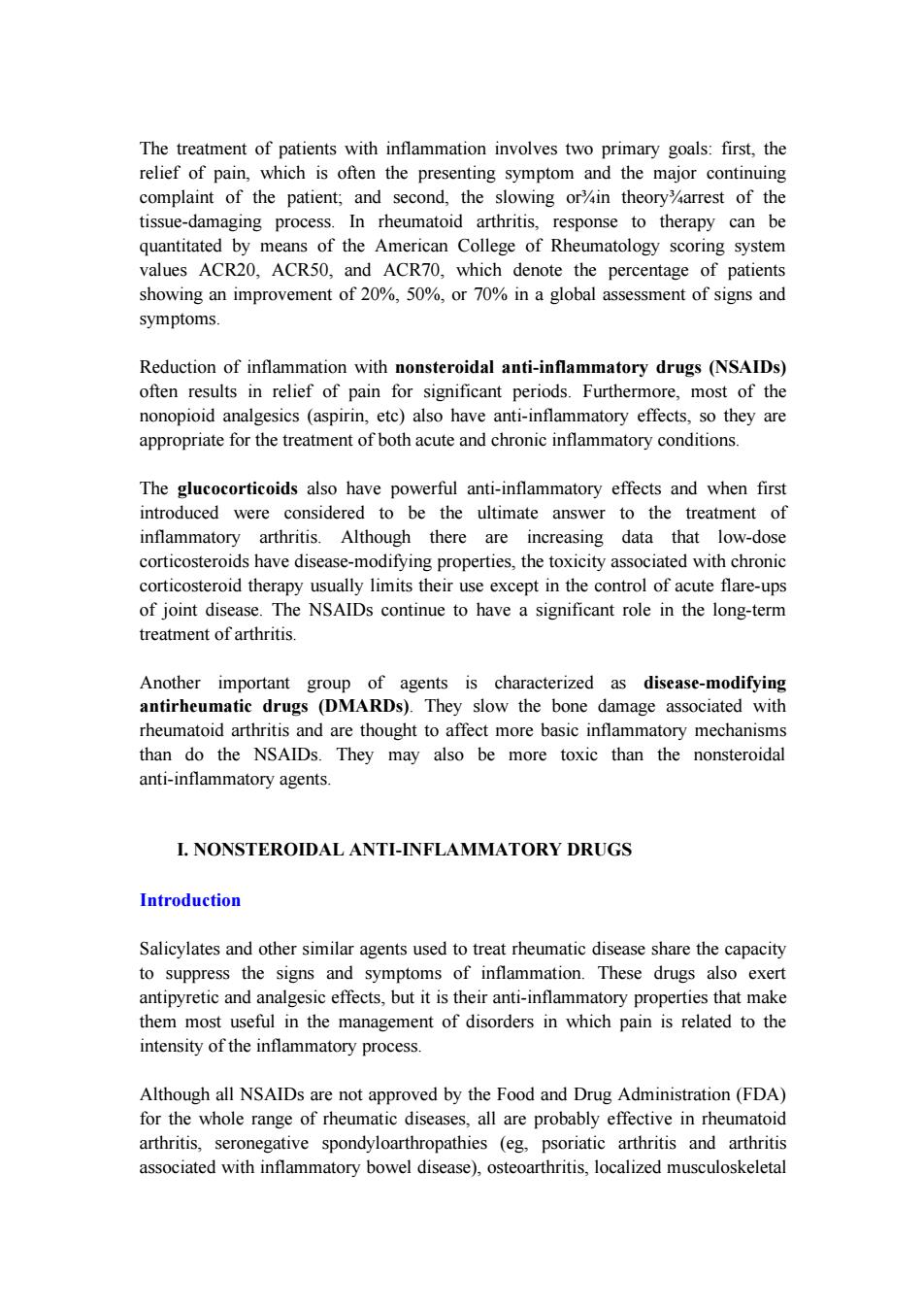正在加载图片...

The treatment of patients with inflammation involves two primary goals:first,the relief of pain,which is often the presenting symptom and the major continuing complaint of the patient;and second,the slowing or%in theoryarrest of the tissue-damaging process.In rheumatoid arthritis,response to therapy can be quantitated by means of the American College of Rheumatology scoring system values ACR20,ACR50,and ACR70,which denote the percentage of patients showing an improvement of 20%,50%,or 70%in a global assessment of signs and symptoms. Reduction of inflammation with nonsteroidal anti-inflammatory drugs (NSAIDs) often results in relief of pain for significant periods.Furthermore,most of the nonopioid analgesics (aspirin,etc)also have anti-inflammatory effects,so they are appropriate for the treatment of both acute and chronic inflammatory conditions. The glucocorticoids also have powerful anti-inflammatory effects and when first introduced were considered to be the ultimate answer to the treatment of inflammatory arthritis.Although there are increasing data that low-dose corticosteroids have disease-modifying properties,the toxicity associated with chronic corticosteroid therapy usually limits their use except in the control of acute flare-ups of joint disease.The NSAIDs continue to have a significant role in the long-term treatment of arthritis. Another important group of agents is characterized as disease-modifying antirheumatic drugs (DMARDs).They slow the bone damage associated with rheumatoid arthritis and are thought to affect more basic inflammatory mechanisms than do the NSAIDs.They may also be more toxic than the nonsteroidal anti-inflammatory agents. I.NONSTEROIDAL ANTI-INFLAMMATORY DRUGS Introduction Salicylates and other similar agents used to treat rheumatic disease share the capacity to suppress the signs and symptoms of inflammation.These drugs also exert antipyretic and analgesic effects,but it is their anti-inflammatory properties that make them most useful in the management of disorders in which pain is related to the intensity of the inflammatory process. Although all NSAIDs are not approved by the Food and Drug Administration(FDA) for the whole range of rheumatic diseases,all are probably effective in rheumatoid arthritis,seronegative spondyloarthropathies (eg,psoriatic arthritis and arthritis associated with inflammatory bowel disease),osteoarthritis,localized musculoskeletalThe treatment of patients with inflammation involves two primary goals: first, the relief of pain, which is often the presenting symptom and the major continuing complaint of the patient; and second, the slowing or¾in theory¾arrest of the tissue-damaging process. In rheumatoid arthritis, response to therapy can be quantitated by means of the American College of Rheumatology scoring system values ACR20, ACR50, and ACR70, which denote the percentage of patients showing an improvement of 20%, 50%, or 70% in a global assessment of signs and symptoms. Reduction of inflammation with nonsteroidal anti-inflammatory drugs (NSAIDs) often results in relief of pain for significant periods. Furthermore, most of the nonopioid analgesics (aspirin, etc) also have anti-inflammatory effects, so they are appropriate for the treatment of both acute and chronic inflammatory conditions. The glucocorticoids also have powerful anti-inflammatory effects and when first introduced were considered to be the ultimate answer to the treatment of inflammatory arthritis. Although there are increasing data that low-dose corticosteroids have disease-modifying properties, the toxicity associated with chronic corticosteroid therapy usually limits their use except in the control of acute flare-ups of joint disease. The NSAIDs continue to have a significant role in the long-term treatment of arthritis. Another important group of agents is characterized as disease-modifying antirheumatic drugs (DMARDs). They slow the bone damage associated with rheumatoid arthritis and are thought to affect more basic inflammatory mechanisms than do the NSAIDs. They may also be more toxic than the nonsteroidal anti-inflammatory agents. I. NONSTEROIDAL ANTI-INFLAMMATORY DRUGS Introduction Salicylates and other similar agents used to treat rheumatic disease share the capacity to suppress the signs and symptoms of inflammation. These drugs also exert antipyretic and analgesic effects, but it is their anti-inflammatory properties that make them most useful in the management of disorders in which pain is related to the intensity of the inflammatory process. Although all NSAIDs are not approved by the Food and Drug Administration (FDA) for the whole range of rheumatic diseases, all are probably effective in rheumatoid arthritis, seronegative spondyloarthropathies (eg, psoriatic arthritis and arthritis associated with inflammatory bowel disease), osteoarthritis, localized musculoskeletal